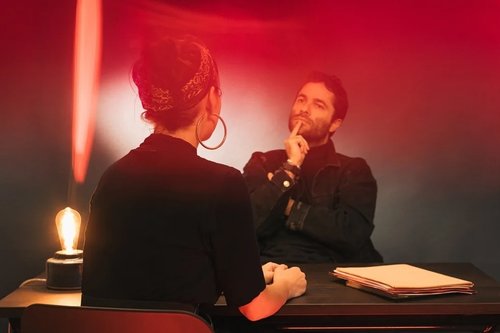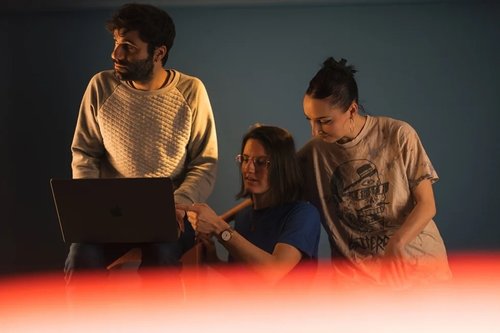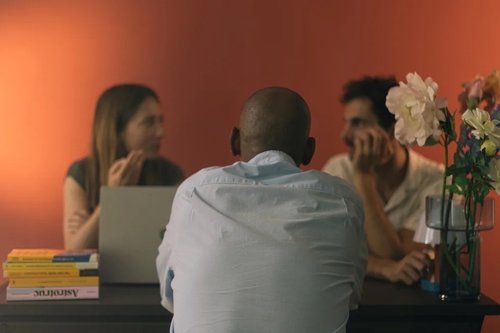Job interview: how to read a recruiter's body language
Jan 05, 2021 - updated Aug 27, 2024
7 mins


Journaliste - Welcome to the Jungle
The topic of non-verbal communication was brought to life for television viewers with Lie to Me, a popular series in which Dr. Cal Lightman, “the world’s leading deception expert,” used his understanding of body language and micro-expressions to help the police to solve crimes. This was not just fiction, however, as Lightman was based on Dr. Paul Ekman, a renowned American psychologist who specializes in this area. Non-verbal communication is also popular with recruiters who use their skills to interpret the body language of applicants at job interviews.
It’s true that this is a powerful means of scrutinizing candidates, especially when it comes to figuring out their personality traits. But what if it were time to turn the tables on them by having applicants use this discipline? Because in the end, it doesn’t matter what position you find yourself in when you master the tools to decipher someone else’s body language. Julie Salvador, an expert in “synergology” and a coach in voice communication, has a few tips to help you to better understand the recruiter during a job interview.
What is synergology?
According to Salvador, synergology can be defined as “a discipline whose objective is to decipher the functioning of the human mind from its body language.” Following this logic, the role of the synergologist is to understand the thoughts of a person through their body language. Simply put, it’s to optimize communication with that person so that you both can have a better exchange.
It’s important to remember that you can’t really access another person’s thoughts, so each piece of information you pick up is only ever the result of subjective interpretation. A gesture can be related to what a person is thinking, to what they are saying at a specific moment, to their environment, or even to something they are feeling that has nothing to do with the professional context. “So while you’re not exactly in the other person’s head, what you observe will allow you to intelligently question their gestures,” said Salvador. “The theories of synergology allow us to compensate for the maximum possible bias. In particular, by focusing on the anchoring of a person in a specific situation to know if, for example, the person is in their head or if they’re with us [in the conversation].”
And unlike neuro-linguistic programming (NLP), a set of techniques that aims to help an individual change the way they perceive their environment, synergology does not aim to change a person’s behavior. “During a coaching session, we are not going to teach on how to use appropriate gestures, since there are no good or bad gestures. On the other hand, we will help the person become aware of certain attitudes, which will give them a sufficient head start to adapt their behavior and thus optimize any form of dialogue.”
How can it be useful during a job interview?
Synergology can be just as helpful in everyday life as it can be in job interviews. Its primary purpose is to develop the power of observation in order to help you to adapt to the interviewer in front of you. And what better way to go through an interview than to be able to decipher how a recruiter works to maximize your chances of winning them over? “It’s not really about being able to get them to like you at all costs. Because if you put yourself in this situation, you run the risk of conforming to what the recruiter expects of you, and then falling into a form of counterproductive seduction,” said Salvador.
“You’ll end up not being yourself anymore and the communication will cease to be honest. This approach is all the more dangerous if the candidate is subsequently hired having put the recruiter’s expectations ahead of their own. The time they spend in that company may then feel a bit long for them.” So drop the seduction act and think about adapting instead. “The more the applicant is able to adapt to the person facing them, as well as to the environment around them, the smoother the communication will be and the more trust will be established.”
How to read your recruiter
When it comes to understanding a recruiter, the first step is to observe what is going on around you, rather than focusing on what impression you are making. The focus is often on what you want to say or do, rather than on the main person involved: the recruiter. But any clue as to whether your interview is going well or not will come from them. So keep your eyes open, all the while remaining anchored in the present moment—otherwise, you risk missing out on the exchange. Here’s an overview of the keys to understanding and optimizing your time in an interview the Lie to Me way.
1. Be ready to adapt
To make any form of communication smoother, nothing works better than being adaptable. As soon as your attitude matches that of the person in front of you, you create a synchronization of movement. And when an exchange goes smoothly, each person’s body language instinctively reflects the other’s. “It’s not about imitating the recruiter, but rather of being aware that the basis of the exchange will be guided by the other person in order to be in sync with them,” said Salvador.
When it comes to adapting, there is nothing better than giving the recruiter space, especially at the beginning of the interview. Linda Blair, a clinical psychologist, has said that it takes only seven seconds for us to judge another person when we first meet them. This very small lapse of time is all the more essential since it can influence the whole interview.
But if, as an applicant, you are judged in these first few moments, it’s also your chance to read their character. Are they friendly, stressed, or withdrawn? It’s worth noting, because the way you address them should change depending on their attitude. “If the recruiter seems distant, it may not be worth getting too close to them or invading their space, because it may mean that they are voluntarily keeping their distance to better evaluate you,” said Salvador. In short, it’s up to you to spot the subtle signals.
2. Easily discern good vibes…
Anyone can instinctively sense if an interview is going well. But if in doubt, here are some keys to confirm if you’re making a good impression:
Interest
If the recruiter is open to communication and shows a real interest in your application, their chair will be positioned at the center of the table with their body leaning forward towards you.
If they touch their forehead area, they are thinking. This means not only that they are really interested in what you are saying, but also that they are taking it all in or even projecting ahead.
If they blink, it’s a good sign. Blinking makes it possible to memorize a given piece of information, which shows that it’s being anchored in the present moment.
Enthusiasm
Moving their eyebrows is always a positive sign, because the eyebrow area symbolizes connection. It means that they are open to the encounter. This is why people who don’t show any response often seem less friendly.
If they smile in reaction to what you’re saying—bingo! It’s almost always a sign of satisfaction or encouragement. To detect a genuine smile, remember that it takes in the whole face, especially the eyes, not just the mouth. When someone is really smiling, you can see and hear it in their voice. So don’t see masks as an obstacle to communication, but rather as a way to tell real smiles from fake ones.
3. …and bad vibes
This can be much harder to detect, so here are a few key details that are often a bad sign. The goal is to spot them as quickly as possible and then to turn the tables in your favor.
Dissatisfaction
If the recruiter scratches their cheek, it’s considered to be a sign of annoyance and irritation. Think about what you might have said or implied so that you may correct this.
If they move forward in their chair while you are talking, and then suddenly move backward, they are withdrawing from communication. In other words, something you’ve said has displeased them or made them think twice. You’ll then have to pull them back into the conversation. The best way to do this is to ask them a specific question about the position or about the company in general. So make sure to read up on the company beforehand so that you have some questions ready.
Uncertainty
If the person is constantly moving around in their chair and is having a hard time finding a comfortable position, it means they’re also having difficulty figuring out something in their head. This difficulty will also be visible if they scratch their chin because this area symbolizes doubt. So it’s up to you to make the right argument.
If the recruiter is stressed, you will hear it, as the voice becomes curt and staccato when under pressure. Listen to how quickly they’re speaking—if it’s getting faster, it means you need to move on.
Impatience
If the recruiter puts their finger on their mouth, it’s because they’re waiting for you to finish your answer, but more importantly because they really want to have their turn to speak. So it’s important to keep it short—remember, an interview is first and foremost about having a discussion.
If they tap their fingers on the table, or tap with an object, it means that you’re not answering fast enough for them. It’s time to pick up the pace.
Boredom
If the recruiter is blinking infrequently or not at all, it’s often because you’ve lost them. Are they actually looking at you when they nod their head? You might see a lack of body movement as if the person has remained frozen in their position. It’s up to you to win back their interest by pulling them back into the conversation as quickly as possible. Perhaps with a well-placed reference or a strategic question?
Authority
If the recruiter moves backward, it is because they are creating a physical distance between themselves and the applicant. And if they adjust their clothing in any way, or touch the area between the lips and the nose, it means that they’re trying to reclaim their authority. In this situation, it is wise to show respect for the hierarchy by not trying to invade their space. Also, you can subtly acknowledge their authority, since they feel the need to assert it, by asking about their position within the company, for example.
Observation is essential
To be a good observer, you must first be comfortable with being observed and evaluated. It’s normal for interviewees to feel uneasy in such situations, but that’s often the root cause of the stress that applicants feel, along with the fear of not being able to answer difficult questions.
This stress, however, can get in the way of any interaction or analysis. This is why it is essential to be prepared and to take a positive approach to any interview. It is difficult to gain a recruiter’s confidence if you are not confident in yourself. If you remain open-minded, attentive to the recruiter, and ready to adapt to the environment, you will increase your chances of success. So now, it’s up to you!
Translated by Kalin Linsberg
Photo by Thomas Decamps Welcome to the Jungle
Follow Welcome to the Jungle on Facebook, LinkedIn, and Instagram, and subscribe to our newsletter to get our latest articles every day!

More inspiration: Ace your job interview

Why are you leaving your job? Here's how to nail the answer
Caught off guard by 'Why are you leaving your job?' Here's how to flip this tricky question into a spotlight on your goals and potential.
Dec 24, 2024

Standing out in an interview: Creative responses to common questions
Answering common interviews with common responses isn't going to get you far in today's job market. Here's how to truly stand out!
Nov 26, 2024

The Pratfall Effect: Can screwing up in a job interview make you more likable?
Mistakes you make in a job interview could actually work to your advantage ...
Oct 14, 2024

How to bring up your long-term career goals in an interview
Be honest but strategic. The key is aligning your goals with the role while showing flexibility and ambition. Avoid faking it!
Sep 24, 2024

Is honesty the key to discussing your weaknesses?
Are your weaknesses holding you back in an interview? A bit of honesty can flip the script and make your flaws work in your favor.
Aug 21, 2024
The newsletter that does the job
Want to keep up with the latest articles? Twice a week you can receive stories, jobs, and tips in your inbox.

Looking for your next job?
Over 200,000 people have found a job with Welcome to the Jungle.
Explore jobs